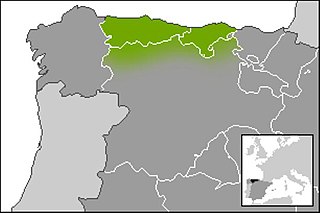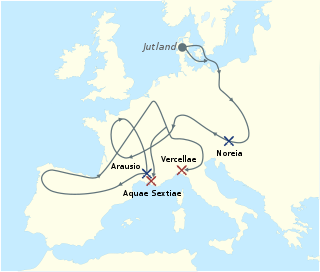Related Research Articles
From its origin as a city-state on the peninsula of Italy in the 8th century BC, to its rise as an empire covering much of Southern Europe, Western Europe, Near East and North Africa to its fall in the 5th century AD, the political history of Ancient Rome was closely entwined with its military history. The core of the campaign history of the Roman military is an aggregate of different accounts of the Roman military's land battles, from its initial defense against and subsequent conquest of the city's hilltop neighbors on the Italian peninsula, to the ultimate struggle of the Western Roman Empire for its existence against invading Huns, Vandals and Germanic tribes. These accounts were written by various authors throughout and after the history of the Empire. Following the First Punic War, naval battles were less significant than land battles to the military history of Rome due to its encompassment of lands of the periphery and its unchallenged dominance of the Mediterranean Sea.

Publius Cornelius Scipio Africanus Aemilianus, known as Scipio Aemilianus or Scipio Africanus the Younger, was a Roman general and statesman noted for his military exploits in the Third Punic War against Carthage and during the Numantine War in Spain. He oversaw the final defeat and destruction of the city of Carthage. He was a prominent patron of writers and philosophers, the most famous of whom was the Greek historian Polybius. In politics, he opposed the populist reform program of his murdered brother-in-law, Tiberius Gracchus.

The Celtiberians were a group of Celts and Celticized peoples inhabiting an area in the central-northeastern Iberian Peninsula during the final centuries BC. They were explicitly mentioned as being Celts by several classic authors. These tribes spoke the Celtiberian language and wrote it by adapting the Iberian alphabet, in the form of the Celtiberian script. The numerous inscriptions that have been discovered, some of them extensive, have allowed scholars to classify the Celtiberian language as a Celtic language, one of the Hispano-Celtic languages that were spoken in pre-Roman and early Roman Iberia. Archaeologically, many elements link Celtiberians with Celts in Central Europe, but also show large differences with both the Hallstatt culture and La Tène culture.

The Astures or Asturs, also named Astyrs, were the Hispano-Celtic inhabitants of the northwest area of Hispania that now comprises almost the entire modern autonomous community of Principality of Asturias, the modern province of León, and the northern part of the modern province of Zamora, and eastern Trás os Montes in Portugal. They were a horse-riding highland cattle-raising people who lived in circular huts of stone drywall construction. The Albiones were a major tribe from western Asturias. Isidore of Seville gave an etymology as coming from a river Astura, identified by David Magie with Órbigo River in the plain of León, by others the modern Esla River.

The Battle of Ilipa was an engagement considered by many as Scipio Africanus’s most brilliant victory in his military career during the Second Punic War in 206 BC.

The Cantabri or Ancient Cantabrians, were a pre-Roman people and large tribal federation that lived in the northern coastal region of ancient Iberia in the second half of the first millennium BC. These peoples and their territories were incorporated into the Roman Province of Hispania Tarraconensis in 19 BC, following the Cantabrian Wars.

The Cantabrian Wars, sometimes also referred to as the Cantabrian and Asturian Wars, were the final stage of the two-century long Roman conquest of Hispania, in what today are the provinces of Cantabria, Asturias and León in northwestern Spain.

The Cimbrian or Cimbric War was fought between the Roman Republic and the Germanic and Celtic tribes of the Cimbri and the Teutons, Ambrones and Tigurini, who migrated from the Jutland peninsula into Roman-controlled territory, and clashed with Rome and her allies. The Cimbrian War was the first time since the Second Punic War that Italia and Rome itself had been seriously threatened.

The Roman Republic conquered and occupied territories in the Iberian Peninsula that were previously under the control of native Celtic, Iberian, Celtiberian and Aquitanian tribes and the Carthaginian Empire. The Carthaginian territories in the south and east of the peninsula were conquered in 206 BC during the Second Punic War. Control was gradually extended over most of the Iberian Peninsula without annexations. It was completed after the end of the Roman Republic, by Augustus, the first Roman emperor, who annexed the whole of the peninsula to the Roman Empire in 19 BC.

The Celtiberian oppidum of Numantia was attacked more than once by Roman forces, but the siege of Numantia refers to the culminating and pacifying action of the long-running Numantine War between the forces of the Roman Republic and those of the native population of Hispania Citerior. The Numantine War was the third of the Celtiberian Wars and it broke out in 143 BC. A decade later, in 133 BC, the Roman general and hero of the Third Punic War, Scipio Aemilianus Africanus, subjugated Numantia, the chief Celtiberian city.
The Second Celtiberian War was one of the three major rebellions by the Celtiberians against the presence of the Romans in Hispania.
The First Celtiberian War and Second Celtiberian War were two of the three major rebellions by the Celtiberians against the presence of the Romans in Hispania.
The First Celtiberian was the first of three major rebellions by the Celtiberians against the Roman presence in Hispania. The other two were the Second Celtiberian War and the Numantine War. Hispania was the name the Romans gave to the Iberian Peninsula. The peninsula was inhabited by various ethnic groups and numerous tribes. The Celtiberians were a confederation of five tribes, which lived in a large area of east central Hispania, to the west of Hispania Citerior. The eastern part of their territory shared a stretch of the border of this Roman province. The Celtiberian tribes were the Pellendones, the Arevaci, the Lusones, the Titti and the Belli.

The Carpetani were one of the Celtic peoples inhabiting the Iberian Peninsula prior to the Roman conquest. Their core domain was constituted by the lands between the Tagus and the Anas, in the southern Meseta. Agriculture is thought to have had a greater importance in the Carpetanian economy than other neighboring peoples'.

The Arevaci or Aravaci, were a Celtic people who settled in the central Meseta of northern Hispania and dominated most of Celtiberia from the 4th to late 2nd centuries BC. The Vaccaei were their allies.

The Lima River runs west from the autonomous community of Galicia in Spain to Portugal, where it enters the Atlantic Ocean at Viana do Castelo, covering 108 kilometres (67 mi).
This section of the timeline of Hispania concerns Spanish and Portuguese history events from the Carthaginian conquests to before the barbarian invasions.
Tanginus was a chieftain of the Celtiberians, active during the Numantine War.

Warfare in ancient Iberian peninsula occupied an important place in historical chronicles, first during the Carthaginian invasion of Hispania, including the Punic Wars, and later during the Roman conquest of the peninsula. The densely bellicose character of the Pre-Roman peoples who inhabited Hispania was repeatedly shown in their conflicts against Rome, Carthage and each other.

Mercenary life is recorded as a custom of Iron Age Spain, particularly in the central area of the Iberian peninsula. Departing from the native tribe and applying to serve in others was a way for economically disadvantaged youth to escape poverty and find an opportunity to use their fighting skills. Starting from 5th century BC, mercenary life would become a true social phenomenon in Hispania, with great numbers of fighters from distant lands coming to join the armies of Carthage, Rome, Sicily and even Greece, as well as other Hispanic peoples.